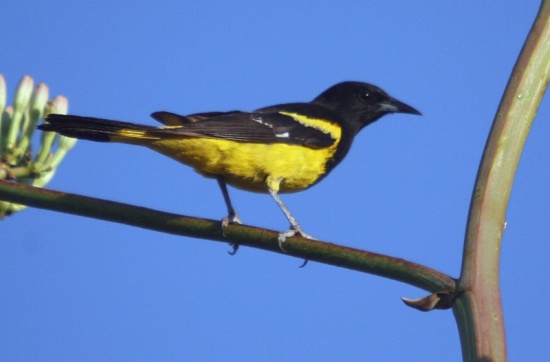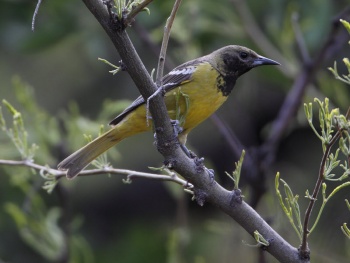- Icterus parisorum
Identification
17 cm. Sharply-pointed bill, which is relatively slender and usually has pale grey limited to the inner half of the bill
Male: black head, breast, back, wings and tail, yellow belly, rump and shoulder patch, white wing bar.
Female: greenish upperparts, dark streaks on back, yellowish underpart, two wing bars.
Similar species
The lemon-yellow of the adult male combined with the patterning is specific. The adult female will at least sometimes remind of females of several other orioles: comparing with e.g., Bullock's Oriole it has a much more evenly colored underside with more olive-yellow and less grey.
Distribution
Breeds: Southwest United States from southern California, most of Nevada, southcentral Idaho, Utah, and southwestern Wyoming.
Mexico: in Baja California and in most of the drier interior Mexico south to Oaxaca.
Migratory at least in northern populations, winter range overlaps with southern part of breeding range.
Accidental north of range and also to Ontario, Nebraska, Kansas, Louisiana, Minnesota, Wisconsin, New York, and Pennsylvania.
Taxonomy
Habitat
Dry woodland, arid oak scrub, yucca desert scrub, pinyon-juniper woodland,desert grassland prairies and mountain canyons.
Behaviour
It nests in pinyon-juniper woodlands, sycamores, and cottonwoods.
References
- Clements, J. F., T. S. Schulenberg, M. J. Iliff, B.L. Sullivan, C. L. Wood, and D. Roberson. 2013. The eBird/Clements checklist of birds of the world: Version 6.8., with updates to August 2013. Downloaded from http://www.birds.cornell.edu/clementschecklist/download/
- Howell & Webb, 1995. A guide to the birds of Mexico and northern Central America. Oxford University Press. ISBN 0198540124
- Birds of North America online
Recommended Citation
- BirdForum Opus contributors. (2025) Scott's Oriole. In: BirdForum, the forum for wild birds and birding. Retrieved 11 May 2025 from https://www.birdforum.net/opus/Scott%27s_Oriole
External Links
GSearch checked for 2020 platform.






